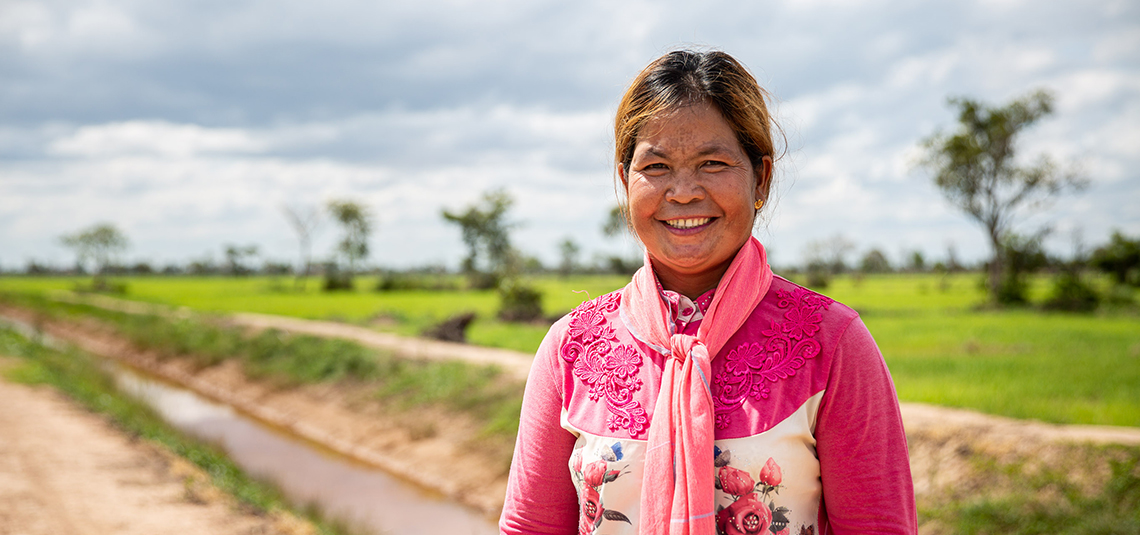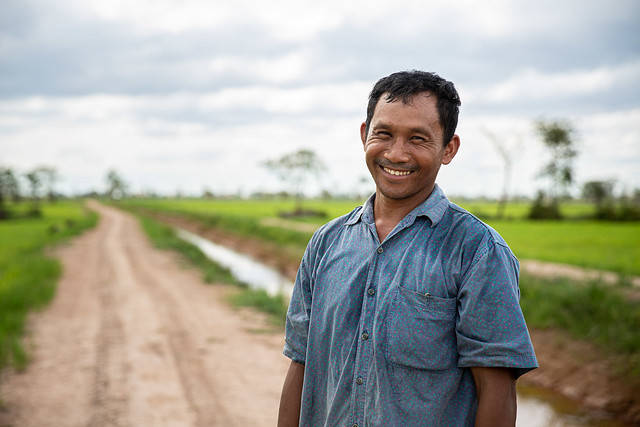
Photo:
Cambodia is one of the poorest nations in South-East Asia. Approximately 70% of Cambodian households derive all or an important part of their income from agriculture, yet the majority of agricultural production is dependent on the monsoon rain and natural floods/recession of the Tonle Sap Lake and Mekong River.
Climate change is likely to disrupt the natural cycle of the monsoonal system and the hydrological function of the interconnected Mekong-Tonle Sap River drainage system and therefore cause a significant impact on the livelihood and welfare of rural Cambodians.
This project (2015-2020) is reducing the vulnerability of rural Cambodians, especially land-poor, landless and/or women-headed households through investments in small-scale water management infrastructure, technical assistance to resilient agricultural practices, and capacity building support for improved food production in home gardens. The project is being implemented in 89 communes and 10 districts of Siem Reap and Kampong Thom provinces.
- Community
- Country Office
- Local Governments
- National Governments
- Non-Governmental Organizations
- United Nations Development Programme (UNDP)
- Government of Cambodia
- Global Environment Facility (GEF)
This project has been designed to reduce the vulnerability of rural Cambodians, especially land-poor, landless and/or women-headed households.
This will be achieved through investments in small-scale water management infrastructure, technical assistance to resilient agricultural practices, and capacity building support, especially targeting poor women, for improved food production in home gardens. Importantly, these services will be delivered by sub-national administrations (communes, districts and provinces) with a view to strengthen their overall capacity to plan, design and deliver public services for resilience building. The objective of the project, therefore, is to improve sub-national administration systems affecting investments in rural livelihoods through climate sensitive planning, budgeting and execution.
Outcome 1, Climate Sensitive Planning, Budgeting and Execution at Sub-National Level Strengthened, builds on the existing system of development planning at District and Commune levels. In particular, mainstreaming of climate change adaptation in the plans and investment programmes of ten Districts and their constituent Communes will be supported. Technical capacity for climate-sensitive agriculture extension and for planning and implementation of climate resilient infrastructure investments will also be developed.
Outcome 2, Resilience of Livelihoods of the most vulnerable improved against erratic rainfall, floods and droughts, will facilitate investments in small scale water management infrastructure which will contribute to resilient agricultural production, in particular by overcoming unpredictable rainfall during the wet season. Beneficiaries will be members of vulnerable communities identified through the sub-national planning process and a detailed, participatory Farmer Needs Assessment will be carried out to identify suitable improvements to resilient agricultural livelihoods. Groups of poor and vulnerable women will be assisted to develop livelihood activities requiring only limited amounts of land and will receive complementary support for social capital building activities including leadership training and formation of savings groups.
Outcome 3, Enabling environment is enhanced at sub-national level to attract and manage greater volume of climate change adaptation finance for building resilience of rural livelihoods, will result in an improved system of performance assessment for climate change adaptation by sub-national governments, linked to the Performance Based Climate Resilience Grant awards that will co-finance infrastructure investments under Outcome 2. The capacity of the sub-national administrations to monitor, evaluate and plan improvements in capacity and performance for climate change adaptation will be strengthened.
The Ministry of Environment of the Royal Government of Cambodia will be the Implementing Partner, with a number of key technical Ministries providing support which will be coordinated through a Technical Advisory Group. To ensure cross-sectoral integration, responsiveness to local needs and sustainability, sub-national activities of the Project will be integrated with the NP-SNDD under the coordination of NCDD-S. The Project will be implemented in 89 Communes and ten Districts of Siem Reap and Kampong Thom Provinces over a four year period beginning in 2015.
This project aims to improve sub-national administration systems affecting investments in rural livelihoods through climate sensitive planning, budgeting and execution. Its key outcomes include:
- Climate sensitive planning, budgeting and execution at sub-national level strengthened;
- Resilience of livelihoods of the most vulnerable improved against erratic rainfall, floods and droughts; and
- Incentive mechanism is in place at sub-national level to manage greater volume of climate change adaptation financing aligned with local development plans.
Update on results, July 2019
· A total of 389 provincial, district and commune councilors (129 women – 33%) have been actively involved in the process of integrating CCA into local planning and execution of CCA priorities. To date, at commune level, 79 out of 89 target communes have fully integrated climate change adaptation and gender into its plans and programs, leveraging the results from the vulnerability reduction assessment (VRA) exercises in each commune, resulting in 8 DIPs and 63 CIPs having included specific budget for adaptation actions.
· The project’s baseline data to measure the impact of the project was established and baseline survey report is now available. The survey involved a total of 1,563 household respondents, a combination of 726 treatments, 422 control-1, and 415 control-2 households in both target provinces. In June 2019, a mini survey was conducted in 28 treatment (T) villages to assess the potency of the ongoing project interventions, the result of which guides towards the intended impacts.
· Technical capacity of agricultural extension officers and livelihood service provider have been enhanced for climate-resilient livelihood to provide support to the local communities through a series of capacity building workshops on beneficiary selection and resilient agriculture extension packages. As a result, total of 115 extension officers, service provider staff, and Sub-National Administration staff (34 women—30%) are able to facilitate and provide technical support to project beneficiaries.
· The project has supported 4,154 households in 81 villages to implement resilient livelihood income generation and water management related activities, representing 69% of 6,000 target households. 92% out of the engaged households are adopting the resilient agriculture activities including chicken, duck and frog raising, home vegetable gardening and resilient rice farming. From field observation, it was noted that farmers raise 20 to 150 chicken per households. They could earn an average from 100,000 Riels ($25) to 800,000 Riels ($200) per 3 months. To measure the development results, the project will conduct an impact survey at the end of the project.
· To date, 88 out of 100 target water schemes in 10 districts have been implemented in a total amount of $1,400,000 through a co-financed mechanism with the Commune Fund (Performance-Based Climate Resilient Grant – PBCRG). While some schemes are under the technical design and construction processes, the 49 completed schemes are now estimated to directly irrigate 2,545 hectares of rice paddies and benefit 4,155 households in 45 communes in both target provinces. To ensure durable water infrastructures and effective use of water resources, to date, 20 FWUC/WUGs (10 in each target province) have been established with a total member of 1,696 farmer households as water users with a common irrigated areas of 1,039 ha rice paddies. Having visited to the areas, farmers manage to do double rice crops and are able to cope with dry spell and drought. It’s easily observed that the farmers are happy as they could early access to water for their rice crop without waiting for sufficient rain water.
· In collaboration with other initiatives, the project supported the NCDDS to update the existing PBCR grant manual. It has been approved by the NCDD and implemented in 10 target districts covering 89 target communes with enhanced climate-smart development planning integrated. The capacity of NCDDS and the SNAs on PBCR grant assessment and self-monitoring strengthened through hands-on training and assessment exercises. They are now able to prepare and conduct PBCR assessment on the annual basis.
See UNDP's Transparency Portal.
- Yusuke TaishiRegional Technical Advisor, CCA
- UNDPPinreak SuosNational Project Advisor

